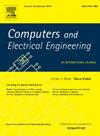Nonlinear integral backstepping control based on particle swarm optimization for a grid-connected variable wind energy conversion system during voltage dips
IF 4
3区 计算机科学
Q1 COMPUTER SCIENCE, HARDWARE & ARCHITECTURE
引用次数: 0
Abstract
Double-fed induction generator (DFIG) wind turbines connected to the grid are particularly subject to grid problems such as voltage dips. Because of this, it might be challenging to maintain system stability and prevent system disconnections when using a Proportional-Integral (PI) Controller to operate this system. This paper applies the Integral Backstepping Control for the wind power plant system connected to the power grid. The Integral Backstepping is a nonlinear and recursive method that employs the Lyapunov theory to ensure the system's stability. The best selection of gain values for the Lyapunov function guarantees improved system control. These gains are frequently adjusted using the trial-and-error strategy, which is time-consuming and inefficient. This technique becomes more complex when many parameters need to be determined. It also limits the system's performance and restricts this nonlinear approach's advantages. The objective is to apply the particle swarm optimization for computing several constant values of the nonlinear approach by minimizing an integral absolute error criterion index. The weighted sum of errors is employed to solve the multiple objective problems. The proposed controller tracks the maximum power point, maintains the voltage of the DC-Link constant, and controls active and reactive power. The robustness of this method is verified in critical conditions, including system parameter variation and asymmetrical and symmetrical grid faults. The simulation findings highlight the effectiveness and robustness of the combination of Integral Backstepping with Particle Swarm Optimization in terms of reducing response time from 10.6 (ms) to 2 (ms), canceling static error, and improving overshoot compared to the vector control based on PI regulator. Besides, the DC-Link voltage ripples during the asymmetrical grid faults are reduced to ±1 (V) using the suggested controller. The latter can be implemented thanks to advancements in Central Processor Unit technology.
基于粒子群优化的非线性积分反步控制,用于电压骤降期间的并网可变风能转换系统
与电网相连的双馈异步发电机(DFIG)风力涡轮机尤其容易受到电压骤降等电网问题的影响。因此,在使用比例积分(PI)控制器运行该系统时,要保持系统稳定并防止系统断开可能具有挑战性。本文对与电网相连的风力发电厂系统采用了积分反向步进控制。积分反步法是一种非线性递归方法,采用 Lyapunov 理论来确保系统的稳定性。为 Lyapunov 函数选择最佳增益值可确保改善系统控制。这些增益经常使用试错策略进行调整,既费时又低效。当需要确定许多参数时,这种技术就会变得更加复杂。它还限制了系统的性能,限制了这种非线性方法的优势。我们的目标是应用粒子群优化技术,通过最小化积分绝对误差标准指数来计算非线性方法的几个常量值。采用误差加权和来解决多目标问题。所提出的控制器可跟踪最大功率点,保持直流链路电压恒定,并控制有功功率和无功功率。该方法的鲁棒性在关键条件下得到了验证,包括系统参数变化以及非对称和对称电网故障。仿真结果表明,与基于 PI 调节器的矢量控制相比,积分反向步法与粒子群优化的结合既有效又稳健,响应时间从 10.6 (ms) 缩短到 2 (ms),消除了静态误差,改善了过冲。此外,使用建议的控制器,不对称电网故障期间的直流链路电压纹波可降至 ±1 (V)。由于中央处理器单元技术的进步,后者得以实现。
本文章由计算机程序翻译,如有差异,请以英文原文为准。
求助全文
约1分钟内获得全文
求助全文
来源期刊

Computers & Electrical Engineering
工程技术-工程:电子与电气
CiteScore
9.20
自引率
7.00%
发文量
661
审稿时长
47 days
期刊介绍:
The impact of computers has nowhere been more revolutionary than in electrical engineering. The design, analysis, and operation of electrical and electronic systems are now dominated by computers, a transformation that has been motivated by the natural ease of interface between computers and electrical systems, and the promise of spectacular improvements in speed and efficiency.
Published since 1973, Computers & Electrical Engineering provides rapid publication of topical research into the integration of computer technology and computational techniques with electrical and electronic systems. The journal publishes papers featuring novel implementations of computers and computational techniques in areas like signal and image processing, high-performance computing, parallel processing, and communications. Special attention will be paid to papers describing innovative architectures, algorithms, and software tools.
 求助内容:
求助内容: 应助结果提醒方式:
应助结果提醒方式:


